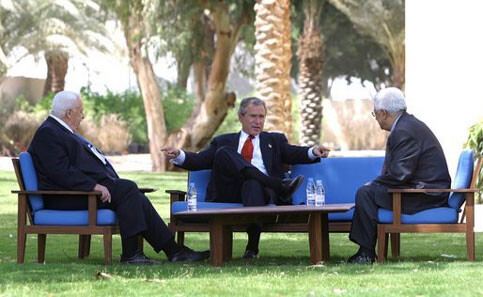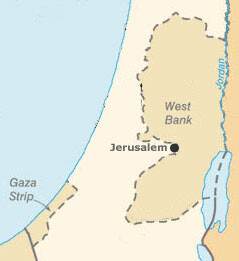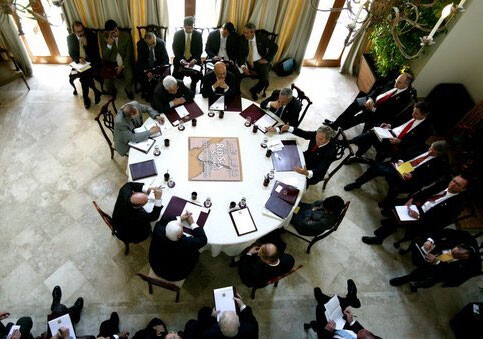The Electronic Intifada 4 June 2003

Above: President George W. Bush, center, discusses the Middle East peace process with Prime Minister Ariel Sharon of Israel, left, and Palestinian Prime Minister Mahmoud Abbas in Aqaba, Jordan, Wednesday, June 4, 2003. (White House/Paul Morse)
President Bush’s two days of Middle East summitry are being hailed in the United States as a diplomatic and political triumph. And indeed even by bringing Arab and Israeli leaders to Sharm al-Sheikh and Aqaba, Bush did more than many people thought was possible. But the elation is likely to be short lived as the carefully crafted final statements by Bush, Israeli prime minister Ariel Sharon, and the Palestinians’ Mahmoud Abbas paper over the lop-sided concessions made by each side.
Prior to the final declarations, the Israeli press was full of stories that Sharon would declare Israel’s non-negotiable conditions for a peace settlement, including the requirement that Palestinians abandon the refugees’ right of return. In the event, the US seems to have imposed on both sides an embargo against stating such preconditions explicitly. But Sharon found other ways to suggest that his sudden appearance of flexibility is nothing more than an illusion designed to deflect American pressure.
Sharon committed himself in principle to a Palestinian “state” and sought to “reassure our Palestinian partners that we understand the importance of territorial contiguity in the West Bank for a viable Palestinian state.” But this is far from reassuring.

Above: The Gaza Strip and West Bank (which includes Jerusalem) represent just 22% of the historic Palestinian homeland. Every day, Israel works to consolidate its hold on Palestinian land through defacto annexation by the Apartheid wall, the razing of homes and agricultural land, and new Israeli settlements. This process of colonisation is the source of the Israeli-Palestinian conflict. Any “solution” that does not address and reverse this process is doomed. (EI)
Let us recall that the first phase of the road map requires an immediate cessation of all settlement construction, and the removal of all settlements established since March 2001 - whose number is estimated by Israel’s Peace Now to be sixty. Sharon was silent about stopping ongoing construction, and pledged to dismantle only the new settlements he considers to be “unauthorized” - a mere handful estimated by the Israeli press to number 7-10. Ha’aretz columnist Gideon Samet warned before the Aqaba summit against such an Israeli fraud, and said that many of the “outposts” were “put up just to pull them out like a goat from a crowded corral.” (Ha’aretz, 4 June 2003)
Bush endorsed this Israeli trickery by stating “I welcome Prime Minister Sharon’s pledge to improve the humanitarian situation in the Palestinian areas and to begin removing unauthorized settlement outposts immediately.”
In recent days, however, Israel’s housing minister Effie Eitam, of the pro-ethnic cleansing National Religious Party, declared that the number of settlers would continue to grow, and “we will build for them, and provide them roads and infrastructure” (Ha’aretz, 2 June 2003). Israeli deputy prime minister Ehud Olmert declared that he didn’t think the Americans meant that Israel should remove even “tens of thousands” of settlers, let alone the hundreds of thousands that are squatting on Palestinian land. And Israel’s occupation “municipality” in Jerusalem announced it plans to go ahead with the construction of “Kidmat Tziyon” (‘Progress of Zion’) a settlement in the West Bank adjacent to occupied East Jerusalem.
Sharon’s statement that “a democratic Palestinian state fully at peace with Israel will promote the long-term security and well-being of Israel as a Jewish state,” is understood in Israel as code for rejecting the right of return. This is consistent with Sharon’s goal to transfer political responsibility for the Palestinian population to someone else, while maintaining sovereignty over their land.
For his part, the Palestinians’ Mahmoud Abbas declared, “There is no military solution to our conflict. We repeat our denunciation and renunciation of terrorism and violence against Israelis wherever they might be.”
He also pledged, “We will exert all of our efforts using all our resources to end the militarization of the intifada and we will succeed. The armed intifada must end, and we must use and resort to peaceful means in our quest to end the occupation and the suffering of Palestinians and Israelis.”
Palestinians expected Abbas to pledge to do everything to stop all attacks on Israeli civilians. Many Palestinians will interpret Abbas’ statement to go much further, calling for an end even to legitimate resistance against the occupation forces. Nevertheless, Palestinians might sign on to this as long as Israel fulfills its commitments under the road map.
But there appears to be little chance of that. While Abbas spoke generously that Palestinians recognize “the suffering of the Jews throughout history,” the “suffering of “Palestinians and Israelis,” and pledged specifically to “take measures to ensure that there is no incitement emanating from Palestinians institutions,” Sharon offered no reciprocal recognition of the suffering his policies, and Israel throughout its history have caused to the Palestinians. Although the road map requires Israel explicitly to end all of its violence and incitement against the Palestinians, Sharon gave only a vague commitment to ” work alongside the Palestinians and other states to fight terrorism, violence and incitement of all kinds” with no reference to the Israeli policies and institutions that are fuelling it.
Sharon pledged that “we will act in a manner that respects the dignity as well as the human rights of all people.” This vague statement offers no comfort at all, since Israel already maintains that absolutely everything it does is in accordance with international human rights law. Therefore, Sharon is not committing himself to any real change in Israeli practices on the ground. Had Sharon, say, pledged to end the demolition of Palestinian homes, then there might have been something to pay attention to.
Where next? President Bush ordered his Secretary of State and National Security Advisor to make pursuing the road map “the highest priority.” But so much depends on implementing the first phase. Already at this early stage, Bush has backed away from a confrontation with Sharon on the key issue of settlements. Sharon will go home from the summit happy, having given the impression of flexibility and boldness while actually conceding nothing. The usual outlet in an impasse is to pile more pressure on the Palestinians. After what Abbas conceded, its hard to see what they have left to give.
Expect things to get bogged down quickly.

Above: President George W. Bush, seated at right, discusses the Middle East peace process with Prime Minister Ariel Sharon of Israel, to the President’s left, and Palestinian Prime Minister Mahmoud Abbas, to the President’s right, during their trilateral meeting in Aqaba, Jordan, Wednesday, June 4, 2003. (White House/Eric Draper)





